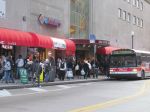Despite an overhaul of Pittsburgh’s public transportation system, which went into effect last year and has carried on in recent months, rider complaints have continued. While the changes were directed at making service more efficient in an effort to increase ridership, many riders still complain about overcrowded buses and unreliable service.
 |
| OUT IN THE COLD—Despite recent service changes, riders say buses are still over crowded and unreliable. (Photo by J.L. Martello)
|
Last week riders were given something else to complain about when the Port Authority of Allegheny County Board of Directors voted in approval of a fare increase and more than 35 percent service reduction.
“The next plan of action is, unless the state adopts a transportation solution, we will cut 35 percent of our service on March 13,” said Jim Ritchie, Port Authority spokesman. “Also, as our next fiscal year starts July 1, 2011, our board likely will be preparing for an additional service cuts starting with the new fiscal year.”
Though the service cuts will not have a significant impact on urban areas, it will eliminate service to more than 50 neighborhoods, many of which are suburban. Board members said this would reduce ridership by 15,000 daily.
The measures approved Nov. 24 are meant to close a $47 million deficit in the $330 million budget. The board also approved a fare increase for Jan. 1 of a quarter for zone 1 riders and 50 cents for zone 2.
The service cuts will eliminate 500 jobs, creating 350 layoffs. Board members said the changes would also impact the city in other ways by adding to an increase in traffic and parking difficulty.
Many with the Port Authority blame state legislators for the current financial crisis, as state funding has not been increased in three years. Alternatively, in recent years, Port Authority has cut spending by $50 million per year.
“Port Authority relies on State Act 44 for a large chunk of its funding. The amount of money provided through Act 44 this year to Port Authority, SEPTA (in Philadelphia), PennDOT, and all other transit agencies is much less due to the failed plan to charge tolls on Interstate 80,” Ritchie said. “Port Authority is seeking a reliable source of funding—something it can count on annually.”
Several bus drivers have placed blame on County Executive Dan Onorato and what they call his mishandling of the drink tax, imposed in 2007. While the drink-tax on alcoholic beverages sold at bars and restaurants was touted as a method for aiding the failing public transit system, it only served as the source of the Port Authority’s usual funding stream, with a minimal increase. One driver, who chose not to be identified, said he and his coworkers believe Onorato would like to see privatization of the transit system.
“Allegheny County always has provided annual funding for Port Authority—historically, about $25 million a year. So, that’s not new,” Ritchie said. “In 2007, after approving the new revenue sources, the Authority’s funding from Allegheny County increased to $27.7 million. So, our net increase in county funding was nearly $3 million. To clarify, we did not continue to receive the $25 million after the new revenue sources were approved. The new funding replaced the old funding.”
While Port Authority drivers and officials are blaming local government, riders are blaming Port Authority itself. Many say they have mismanaged the system and recent changes have done more to hurt than help service.
“In general, the changes we’ve been making through the last year to routes will make the system more productive,” Ritchie said in response to complaints. “We’ve had a few hiccups along the way but certainly have addressed the situations that required corrections.”
Some riders are especially confused over expensive innovations in the transit system such as the underground tunnel being built to provide additional service to the North Shore and the installment of new fare boxes, which Port Authority can not fully utilize until the installment of a smart card system. However, Ritchie explained that these projects are funded through capital dollars and do not come from the system operating budget.
“The fare boxes are in a testing phase and the installation is not nearly complete. They’re only installed at two of our garages. As we install, we are directing our contractor to fix any issues as they arise. That’s what’s occurring now,” Ritchie said. “Despite the statewide crisis, Port Authority will continue to find ways to improve its services and operations. This is a good example. Ultimately, the use of smartcards will be an improvement and an asset that attracts riders. Also, the money being spent on the installation is from the capital budget—not operating budget. Bottom line—capital dollars come from state and federal grants that cannot be used to balance our operating budget. If we didn’t use the money, it would go to another transit system somewhere else.”
(For more information on how the recent changes and service cuts will affect you visit www.portauthority.org.)